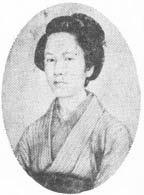
Nakano Takeko
Encyclopedia

Japan
Japan is an island nation in East Asia. Located in the Pacific Ocean, it lies to the east of the Sea of Japan, China, North Korea, South Korea and Russia, stretching from the Sea of Okhotsk in the north to the East China Sea and Taiwan in the south...
ese female warrior
Onna bugeisha
An was a type of female warrior belonging to the Japanese upper class. Many wives, widows, daughters, and rebels answered the call of duty by engaging in battle, commonly alongside samurai men. They were members of the bushi class in feudal Japan and were trained in the use of weapons to protect...
of the Aizu
Aizu
is an area comprising the westernmost third of Fukushima Prefecture in Japan. The principal city of the area is Aizuwakamatsu.During the Edo period, Aizu was a feudal domain known as and part of Mutsu Province.-History:...
domain, who fought and died during the Boshin War
Boshin War
The was a civil war in Japan, fought from 1868 to 1869 between forces of the ruling Tokugawa shogunate and those seeking to return political power to the imperial court....
. Nakano, born in Edo
Edo
, also romanized as Yedo or Yeddo, is the former name of the Japanese capital Tokyo, and was the seat of power for the Tokugawa shogunate which ruled Japan from 1603 to 1868...
, was the daughter of Nakano Heinai, an Aizu official. She was thoroughly trained in the martial and literary arts, and was adopted by her teacher Akaoka Daisuke. After working with her adoptive father as a martial arts instructor during the 1860s, Nakano entered Aizu for the first time in 1868. During the Battle of Aizu
Battle of Aizu
The Battle of Aizu was fought in northern Japan in autumn 1868, and was part of the Boshin War.Aizu was known for its martial skill, and maintained at any given time, a standing army of over 5000. It was often deployed to security operations on the northern fringes of the country, as far north as...
, she fought with a naginata
Naginata
The naginata is one of several varieties of traditionally made Japanese blades in the form of a pole weapon. Naginata were originally used by the samurai class in feudal Japan, and naginata were also used by ashigaru and sōhei .-Description:A naginata consists of a wooden shaft with a curved...
(a Japanese polearm) and was the leader of an ad hoc
Ad hoc
Ad hoc is a Latin phrase meaning "for this". It generally signifies a solution designed for a specific problem or task, non-generalizable, and not intended to be able to be adapted to other purposes. Compare A priori....
corps of female combatants who fought in the battle independently, as the senior Aizu retainers did not allow them to fight as an official part of the domain's army. This unit was later retroactively called the .
Whilst leading a charge against Imperial Japanese Army
Imperial Japanese Army
-Foundation:During the Meiji Restoration, the military forces loyal to the Emperor were samurai drawn primarily from the loyalist feudal domains of Satsuma and Chōshū...
troops of the Ōgaki Domain
Ogaki Domain
The ' was a Japanese domain during the Edo period, located in Mino Province .-History:Historically, the Ōgaki area had been a highly important point of transit from Mino Province to Ōmi Province; it was vital to Saitō Dōsan and later to Oda Nobunaga...
, she received a bullet to the chest. Rather than let the enemy capture her head as a trophy, she asked her sister, Yūko, to cut it off and have it buried. It was taken to Hōkaiji Temple (in modern-day Aizubange
Aizubange, Fukushima
is a town located in Kawanuma District, Fukushima, Japan.As of 2003, the town has an estimated population of 18,779 and a density of 204.90 persons per km². The total area is 91.65 km²...
, Fukushima
Fukushima Prefecture
is a prefecture of Japan located in the Tōhoku region on the island of Honshu. The capital is the city of Fukushima.-History:Until the Meiji Restoration, the area of Fukushima prefecture was known as Mutsu Province....
) and buried under a pine tree.
A monument to her was erected beside her grave at Hōkaiji; Aizu native and Imperial Japanese Navy admiral Dewa Shigetō
Dewa Shigeto
- Notes :...
was involved in its construction. During the annual Aizu Autumn Festival, a group of young girls wearing hakama
Hakama
are a type of traditional Japanese clothing. They were originally worn only by men, but today they are worn by both sexes. Hakama are tied at the waist and fall approximately to the ankles. Hakama are worn over a kimono ....
and white headbands take part in the procession, commemorating the actions of Nakano and her band of women fighters of the Joshigun.

